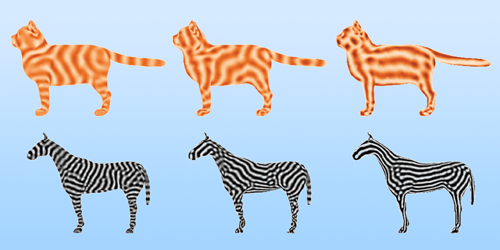How a Zebra’s Stripes Align
According to mathematical models called reaction–diffusion systems, animal stripes could arise from the interaction and diffusion of chemicals or cells in the animal’s skin. But these models don’t explain why animals have stripes with consistent orientations. Michael Staddon of the Max Planck Institute for the Physics of Complex Systems in Germany now proposes an extension to reaction–diffusion theory that could produce this orientational bias [1]. He posits that reaction dynamics—and therefore global stripe alignment—can be influenced by local surface curvature.
In the simplest reaction–diffusion system, an animal’s skin color at any given point is determined by the relative concentrations of two signaling molecules—an activator and an inhibitor. The activator increases production of both molecules, while the inhibitor decreases their production. Fluctuations in the molecules’ concentrations result in instabilities, which drive periodic patterns. But these patterns lack any orientational bias unless the concentration of one species follows a spatial gradient or the species diffuses anisotropically.
Staddon proposes that such anisotropy results from the rates of diffusion being tied to the local surface curvature. Using 3D simulations, he finds that when diffusion decreases in the direction of highest curvature, stripes form hoops—as seen around the torso and legs of tigers and zebras. When diffusion increases with curvature, stripes run lengthwise—as seen in zebrafish. Changing the coupling strength between curvature and diffusion induces stripes in otherwise spotty animals.
Staddon points out that pigmentation patterns tend to appear during embryonic gestation. Curvature–diffusion coupling offers a mechanism for pattern formation during growth, but additional feedback loops may result in more complex forms.
–Rachel Berkowitz
Rachel Berkowitz is a Corresponding Editor for Physics Magazine based in Vancouver, Canada.
References
- M. F. Staddon, “How the zebra got its stripes: Curvature-dependent diffusion orients Turing patterns on three-dimensional surfaces,” Phys. Rev. E 110, 034402 (2024).




